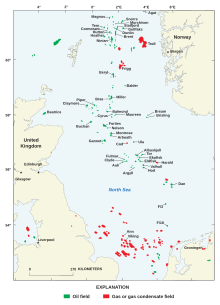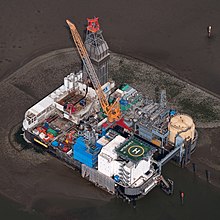
Back نفط بحر الشمال Arabic Şimal dənizinin neftli-qazlı hövzəsi Azerbaijani Severomořská ropa Czech Nordsøolie Danish Nordseeöl German نفت دریای شمال Persian Pohjanmeren öljy Finnish Régions pétrolifères en Europe French Ola na Mara Thuaidh Irish Հյուսիսային ծովի նավթ Armenian
You can help expand this article with text translated from the corresponding article in Danish. (May 2024) Click [show] for important translation instructions.
|


North Sea oil is a mixture of hydrocarbons, comprising liquid petroleum and natural gas, produced from petroleum reservoirs beneath the North Sea.
In the petroleum industry, the term "North Sea" often includes areas such as the Norwegian Sea and the area known as "West of Shetland", "the Atlantic Frontier" or "the Atlantic Margin" that is not geographically part of the North Sea.
Brent crude is still used today as a standard benchmark for pricing oil, although the contract now refers to a blend of oils from fields in the northern North Sea.
From the 1960s to 2014 it was reported that 42 billion barrels of oil equivalent (BOE) had been extracted from the North Sea since when production began. As there is still an estimated 24 billion BOE potentially remaining in the reservoir (equivalent to about 35 years worth of production), the North Sea will remain as an important petroleum reservoir for years to come.[1][2] However, this is the upper end of a range of estimates provided by Sir Ian Wood (commissioned by the UK government to carry out a review of the oil industry in the United Kingdom[3] ); the lower end was 12 billion barrels. Wood, upset with how his figures were being used, said the most likely amount to be found would be between 15 billion and 16 billion barrels.[4]
- ^ "How Much Oil is Left in the North Sea?". People With Energy. Retrieved 3 September 2022.
- ^ "North Sea oil: Facts and figures". BBC News. 24 February 2014. Retrieved 3 September 2022.
- ^ "North Sea oil: Facts and figures". BBC News. BBC. 24 February 2014.
- ^ Mufson, Steven (25 November 2021). "Just how oil rich is Scotland?". Washington Post. ISSN 0190-8286. Retrieved 17 July 2023.
© MMXXIII Rich X Search. We shall prevail. All rights reserved. Rich X Search